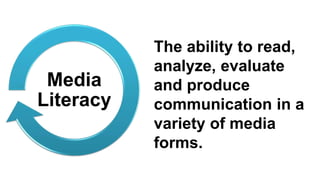MIL WEEK 2.pptxxxxxxxxxxxxxxxxxxxxxxxxxx
- 1. THE MEDIA AND INFORMATION LITERACY Media and Information Literacy 1
- 4. The ability to read, analyze, evaluate and produce communication in a variety of media forms. Media Literacy
- 6. The ability to recognize when information is needed and to locate, evaluate, effectively use and communicate information in its various formats. Information Literacy
- 8. The ability to use digital technology, communication tools or networks to locate, evaluate, use and create information Technology Literacy
- 9. The ability to read, analyze, evaluate and produce communication in a variety of media forms. The ability to recognize when information is needed and to locate, evaluate, effectively use and communicate information in its various formats. The ability to use digital technology, communication tools or networks to locate, evaluate, use and create information Media Literacy Information Literacy Technology Literacy
- 10. MEDIA AND INFORMATION LITERACY (MIL)
- 11. Source: MIL Policy and Strategy Guidelines by UNESCO, 2013 Media and Information Literacy (MIL) refers to the essential competencies (knowledge, skills and attitude) that allow citizens to engage with media and other information providers effectively and develop critical thinking and life-long learning skills for socializing and becoming active citizens
- 12. OBJECTIVES OF MIL ŌĆóGive people an understanding of the importance of media and other information providers in order to: ’ā╝make informed decisions ’ā╝learn about the world around them ’ā╝build a sense of community ’ā╝maintain public disclosure, and ’ā╝engage in lifelong learning 12
- 13. ŌĆó Spur citizens to become active producers of information and innovators of media and information products, as well as critical thinkers. ŌĆó Incite people to use now and traditional media for self-expression, creativity, and greater participation in their countryŌĆÖs democracy and the global information network. 13
- 14. PICTURE ANALYSIS? ’ü▒What can you say about the picture? ’ü▒How do you treat information from the internet? 14
- 15. PICTURE ANALYSIS? ’ü▒What can you say about the picture? ’ü▒How do you treat information from the internet? 15
- 16. Media Literacy Information Literacy Technology Literacy Using the Venn diagram, explain the link and the role of the three concepts in your life as students.
Editor's Notes
- #2: https://i0.wp.com/www.loverecoveryrr.com/wp-content/uploads/2019/04/Episode7-HealthyCommunication.png?resize=650%2C500
- #11: Empowerment of people through Media and Information Literacy (MIL) is an important prerequisite for fostering equitable access to information and knowledge and promoting free, independent and pluralistic media and information systems. Media and Information Literacy recognizes the primary role of information and media in our everyday lives. It lies at the core of freedom of expression and information - since it empowers citizens to understand the functions of media and other information providers, to critically evaluate their content, and to make informed decisions as users and producer of information and media content. Information Literacy and Media Literacy are traditionally seen as separate and distinct fields. UNESCOŌĆÖs strategy brings together these two fields as a combined set of competencies (knowledge, skills and attitude) necessary for life and work today. MIL considers all forms of media and other information providers such as libraries, archive, museums and Internet irrespective of technologies used. http://www.unesco.org/new/en/communication-and-information/media-development/media-literacy/mil-as-composite-concept/
- #12: Empowerment of people through Media and Information Literacy (MIL) is an important prerequisite for fostering equitable access to information and knowledge and promoting free, independent and pluralistic media and information systems. Media and Information Literacy recognizes the primary role of information and media in our everyday lives. It lies at the core of freedom of expression and information - since it empowers citizens to understand the functions of media and other information providers, to critically evaluate their content, and to make informed decisions as users and producer of information and media content. Information Literacy and Media Literacy are traditionally seen as separate and distinct fields. UNESCOŌĆÖs strategy brings together these two fields as a combined set of competencies (knowledge, skills and attitude) necessary for life and work today. MIL considers all forms of media and other information providers such as libraries, archive, museums and Internet irrespective of technologies used. http://www.unesco.org/new/en/communication-and-information/media-development/media-literacy/mil-as-composite-concept/
















